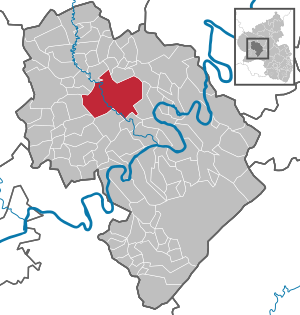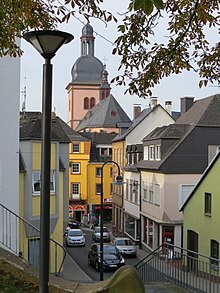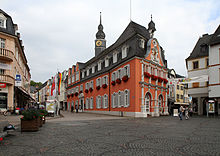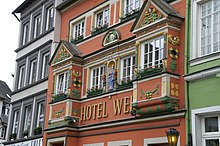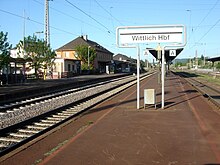Wittlich
| coat of arms | Germany map | |
|---|---|---|

|
Coordinates: 49 ° 59 ' N , 6 ° 53' E |
|
| Basic data | ||
| State : | Rhineland-Palatinate | |
| County : | Bernkastel-Wittlich | |
| Height : | 160 m above sea level NHN | |
| Area : | 49.64 km 2 | |
| Residents: | 19,069 (Dec. 31, 2019) | |
| Population density : | 384 inhabitants per km 2 | |
| Postal code : | 54516 | |
| Area code : | 06571 | |
| License plate : | WIL, BKS | |
| Community key : | 07 2 31 134 | |
| LOCODE : | DE WTH | |
| City structure: | City center + 5 districts | |
City administration address : |
Schlossstrasse 11 54516 Wittlich |
|
| Website : | ||
| Mayor : | Joachim Rodenkirch ( CDU ) | |
| Location of the city of Wittlich in the district of Bernkastel-Wittlich | ||
Wittlich an der Lieser is the district town of the Rhineland-Palatinate district of Bernkastel-Wittlich and the seat of the Wittlich-Land community . With around 19,500 inhabitants, Wittlich is the largest city between Trier and Koblenz and a medium-sized center .
geography
Geographical location
The city is located in the southern Eifel on the Lieser in a side valley of the Moselle on the northern edge of the Wittlich valley . This landscape is limited to the west by the Moselle Eifel and to the east by the Moselle valley .
City or municipality parts
|
|
(Source under: The mentioned local districts were independent municipalities until June 7, 1969.)
climate
The annual precipitation for Wittlich is 721 mm and the number of hours of sunshine adds up to 1861 hours. The mean air humidity is 84% and the mean air temperature (2 m) is 9.7 ° C. The information relates to a period from 1994 to 2012.
history
The oldest known remains of human settlement activity date from the 3rd millennium BC. In Roman times there was a stately villa rustica directly on the Lieser, under today's motorway bridge .
Wittlich was first mentioned in writing in 1065.
1291 gave King Rudolf von Habsburg (1218-1291) Wittlich together with the towns Saarburg , Bernkastel , Welschbillig , Mayen and Montabaur the town charter .
The construction of the archbishop's castle Ottenstein on today's Schlossplatz was completed in 1428. Elector Johann Philipp built a second pleasure palace in 1763, called Philippsfreude .
In the Electorate of Trier , which existed until 1803, the Wittlich office formed an administrative district. After the French era , Wittlich became the seat of the mayor's office in Wittlich and the Wittlich district .
In 1912 the first German juvenile prison was built in Wittlich , which is still adjacent to the Wittlich correctional facility .
On November 9, 1974, the RAF terrorist Holger Meins died in the prison in Wittlich as a result of a hunger strike.
In 2009 the city of Wittlich was included in the Active City Centers program of the State of Rhineland-Palatinate.
- Redesign of the area around the St. Paul Mission House: construction of a generation village as well as a retirement home, scout accommodation, medical center, excursion restaurant and hotel.
Population development
The following table shows the development of the population in the area of the city. People from 86 nations live in Wittlich. The proportion of foreigners is 15% (Germany as a whole 22%, Rhineland-Palatinate 10%).
|
Graphic of the population development

|
industrialization
Social and economic development in the 19th century
The social and economic development before and during the industrialization in Wittlich was characterized by population growth, emigration and social welfare due to increasing poverty.
- Social welfare and emigration
The growing population consisted largely of poor people. Therefore the "Wittlich Association" (1817) was founded to combat starvation. The first institutionalized implementation of poor relief in the town of Wittlich came from a Wittlich women's movement that offered help to the poor by donating food and money to them. On January 17, 1832, a "poor cooks institution" was established in Wittlich (comparable to the Wittlich table ).
Due to poor harvests (1846/47), compulsory military service, poor living conditions and future prospects, lack of work, high taxes and disadvantages for many Moselle winemakers, emigration from Wittlich increased from the middle of the 19th century. The destinations of emigration were America, Russia, Romania or North Africa (Algeria). It was almost exclusively the middle class who could afford to emigrate, as this was associated with high costs and security. In the years 1840–1871, 2133 overseas emigrants were recorded.
- Population growth and economy
The population growth increased disproportionately at the beginning of the 19th century due to the high economic activity. Between the years 1820 and 1900, the population of Wittlich increased from 2002 to 4066 residents. In the 20th century, the population grew comparatively quickly by 2000 residents in just 8 years.
In addition, there were a large number of major projects implemented, such as the district hospital (1900) and the penal institution (1902). [TH1]
During the 19th to the beginning of the 20th century, Wittlich was shaped by the markets of the agricultural and rural population. In this way, local interests were largely covered. In the following course of the entry, the most important and internationally and regionally recognized companies Wittlich are presented.
Railway construction
In the course of the development of railways throughout Germany, discussions have been held since the 1850s about a Moselle railway (Moselle route) from Koblenz to Trier and a hoped-for railway connection to the city of Wittlich.
During the Franco-Prussian War of 1870/71 , the lack of this connection was perceived as serious and the plans were made more concrete. The plans presented in August 1871 were perceived as a negative surprise in Wittlich, as the Moselle Railway was to pass Wittlich between the then independent village of Wengerohr and Platten .
As a result, the Wittlich city council wrote a large number of petitions and submissions to the Reich government and the Reichstag in order to achieve a direct connection between the city and the Moselle route. However, with reference to the higher costs associated with overcoming a greater height difference, these were unsuccessful.
In 1879 the Mosel line Koblenz-Trier was opened, the closest train station for Wittlich was, as it is today, on the edge of Wengerohr.
As a result of the persistent lobbying for a direct connection to Wittlich, the following sections of a branch line from Wengerohr were opened in the following years (closed since the 1980s):
- Wengerohr - Kues 1883
- Wengerohr - Wittlich 1885
- Wittlich - Daun 1909/10
Industrialization in the 20th century
- Merrem & Knötgen wine press factory
The Merrem & Knötgen press factory was founded in Wittlich in 1898 by the partners Joseph Merrem and Matthias Knötgen and initially dealt with the manufacture of steam sawmills and the production of horizontal frame saws . They also tried to structure the public electricity network and supplied some private households until the city of Wittlich saw them as competition. The company then focused on the manufacture of wine and fruit presses , machines, steam engines as well as hay tedders, slurry pumps and their repairs.
The entrepreneurs achieved their greatest success through the pressing , where they also achieved the greatest export successes . New machines such as screw presses made their work easier and made it possible to meet the large demand. A total of 28 of the company's systems were put into operation across Germany. For their outstanding commercial achievements, they received the bronze state medal in 1912 and the gold medal in Budapest in 1914 . Through its international company representatives such as B. in Buenos Aires they achieved world renown as the first company and were an important economic factor in Wittlich, which offered numerous jobs.
In 1917 the factory was sold to the press specialist Julius Heiden. Merrem & Knötgen survived both world wars until they were closed in 1975 for health reasons.
- Timber industry
The Wittlich wood industry was an important branch that contributed to the industrial boom in Wittlich. Since the 1910s there have been many reports about the development of a timber industry, which have become more and more concrete. Dr. Baltz, the chairman of the Association for Industrial Development in the South Eifel, also followed the development of the company Hausmann, Holzindustrie from Blomberg , which was built on the left side of the Wittlich-Daun railway line. The topping-out ceremony was on December 13, 1913. The wood industry was engaged in the production of plywood, which was important for building and furniture joinery. The company was sold several times and was represented at the trade fair in Trier in 1925. At the end of the 1920s, the Wittlich wood industry got into financial difficulties, so that in 1929 a settlement procedure to avoid bankruptcy was opened, which the Wittlich District Court overturned. There are no other sources about the further course of the wood industry in the 1930s, but it is known that the company developed into the largest Wittlich factory and the largest employer at the end of the 1930s.
- Sawmills and woodworks
A prominent factor of industrialization in Wittlich were the wood and sawmills , which dealt with wood trade, wood drying, wood processing and wood products. Notable companies included Hubert Becker's sawmill and planing mill, which was founded in 1889 and thus belonged to one of the oldest wood processing companies in the city of Wittlich. A little later, on April 16, 1920, the "Wittlicher Holzwerke" GmbH was founded, which, until its final dissolution on April 6, 1926, was released for sale or auction several times.
- Chemical factory Ermann and Co.
As a small entrepreneur, the Jewish citizen Salomon Ermann-Bach founded a company for the production of lubricating and shoe greases on January 31, 1884. In the first 25 years the success was only moderate, but in 1909 the company expanded and applied for a newer and larger factory site on the lime tower. Despite the stagnation of the company, the concrete planning of the production facility began immediately after the First World War . The new facility was probably completed in 1921.
The company gradually grew to an international size, as their "Ermin Schuhwichse " was very successful and the factory expanded its production range. They took part in large trade fairs and expanded the factory area considerably in the years that followed. In 1926 the previous sole proprietorship was converted into a general partnership, in which Salomon Ermann-Bach, Josef Bach, as well as Otto and Alfred Ermann were involved. At this time, Alfred Ermann also made more trips to several European countries to advertise his products and to enlarge the company's sales radius.
Significant for Ermann & Co. is the invention of the " spring lid box", a tin box which was provided with a spring and which opened automatically when the closure was opened.
Despite its high profile, the company's owners were expropriated as part of the Aryanization of Jewish businesses in 1936. It was planned that the group should be leased for a fee, but the tenants broke the contract after a short time and payments did not materialize. Because of their Jewish origins, the owners were insulted in letters and even a court case did not result in any change. At the end of 1941, Alfred Ermann's account was also withdrawn by the National Socialists. After emigrating to the Netherlands, Alfred Ermann was murdered in the Sobibor extermination camp in 1943 .
- Other factories
In Wittlich, not only large and relatively well-known companies have a long tradition, but also medium-sized companies, which have driven and maintained industrialization in Wittlich through many small businesses, have contributed to the fact that the economy in Wittlich has remained constant up to the present day high level. Therefore, less well-known factories and businesses should also be mentioned at this point:
| Factory name | owner | mention | Others |
| Yeast factory | Heinrich Neuerburg | Closed in 1866 | Burgstrasse |
| Confectionery Factory | Johann Peter Mohr | In 1882 it still existed | |
| Sugar confectionery factory | Johann Peter Mohr | 1888-1893 | |
| Wax lights factory | Peter Pazen | Founded in 1890 | Trierstrasse 173 |
| Mineral water and lemonade factory | Christof / Philipp Oberst | Founded from 1886 to approx. 1906 (probably in Trier) | |
| Lemonade factory | Peter Schäfer (was later taken over by Heinrich Kaster) | 1921 | Feldstrasse 4 |
| Chair factory | Friedrich Becker | Established in 1905 | 1908 Relocation of business to Trier |
| Chair factory Carl Frings & Co | Carl Frings | 1919 Employees are hired | |
| Chair factory with repair shop | Johann Jost | 1909 | |
| Brush and brush factory | Emil Scheffmacher | 1905 | |
| Cigar, tobacco and cigarette shop | Emil Scheffmacher | 1905 | |
| Straw husk factory | Johann Müller | 1912 | |
| Fruit herb and jam factory | Anton Lombard | 1917 | Sporgraben |
| Wittlich pyrolith plant | Matthias Josef Wagner / Franz Fußhöller | 1921 | |
| Wittlich GmbH steam brickwork | Managing director when it was founded: Hubert Kunibert Gerhard | 1905 | 1908: Factory destroyed by fire
1910: Purchase of the factory by building contractor Hubert Musselock: owner until 1918 |
| Wittlicher steam brickworks Felzen & Meyer | Peter Meyer & Conrad Felzen From 1936: Peter Meyer sole owner |
1918 | Attempt to found a stock corporation by Conrad Felzen 1923 1924: Sale of clinker-hard bricks and various types of sand and gravel |
| Ring kiln brickworks in Neuerburg | Jakob Neuerburg | Established in 1906 | 1920: Sale of the company (location: Hahnerweg) |
| Cement brick factory | Probably Josef Merren | Until shortly before 1900 (last offer 1899) | |
| Dry pressed brick factory | Peter Joseph Pantenburg | 1908 | Presumably held until 1914 |
politics
City council
The City Council of Wittlich consists of 32 members. This is the specified number for a municipality with a population between 15,001 and 20,000. The city council is elected for a five-year term in local elections.
Seat allocation:
| Local election | SPD | CDU | Green | FDP | left | FWG | AfD | total |
|---|---|---|---|---|---|---|---|---|
| May 26, 2019 | 7th | 11 | 6th | 3 | 1 | 3 | 1 | 32 seats |
| May 25, 2014 | 8th | 14th | 4th | 2 | 1 | 3 | - | 32 seats |
| June 7, 2009 | 8th | 13 | 4th | 3 | 1 | 3 | - | 32 seats |
| June 13, 2004 | 9 | 14th | 3 | 3 | - | 3 | - | 32 seats |
| June 13, 1999 | 10 | 16 | 2 | 2 | - | 2 | - | 32 seats |
mayor
In June 2009, Joachim Rodenkirch (CDU) was elected as the full-time mayor of Ralf Bußmer (CDU) in the first ballot . On March 12, 2017, he was confirmed in office for a further eight years with 91.7% of the votes.
The mayor is supported by three councilors, who are currently (as of 2019) Elfriede Meurer (CDU, 1st councilor), Elfriede Marmann (SPD) and Michael Wagner (Bündnis 90 / Die Grünen).
Town twinning
-
 Boxtel , Dutch municipality, since 1959
Boxtel , Dutch municipality, since 1959 -
 Brunoy , French commune, since 1979
Brunoy , French commune, since 1979 -
 Wellingborough , British city, since 1993
Wellingborough , British city, since 1993 -
 Zossen , town in the Teltow-Fläming district ( Brandenburg ), since 1991
Zossen , town in the Teltow-Fläming district ( Brandenburg ), since 1991
Culture and sights
Buildings
- The old town hall on the market square houses a small part of the artistic estate of the painter Georg Meistermann and has meanwhile gained importance as a place for contemporary art under the name Georg-Meistermann-Museum . In 2010 it was renamed the Municipal Gallery for Modern Art before the Hanns Scherl anniversary exhibition . Since 2015 it has been called the Städtische Galerie in the old town hall of Wittlich , which expresses the new exhibition concept in which modern art plays a subordinate role.
- Former synagogue , today a cultural and conference center with a permanent exhibition on Jewish life in Wittlich
- "Turmchen", part of an old city gate
- Baroque parish church of St. Mark
- Neo-Gothic Evangelical Christ Church
- Remains of a Roman villa located between Wittlich and Altrich , next to the federal motorway 1 . During excavations between 1904 and 1907 and 1940, it was still in excellent condition, but was partially destroyed in the 1970s for the construction of a motorway bridge.
- Missionshaus St. Paul der Steyler Missionare (closed in autumn 2005) with the motorway church St. Paul
- House Daus in Karrstrasse 19-21 is one of the oldest town houses in Wittlich
Stumbling blocks
Since 2014, the first stumbling blocks by the artist Gunter Demnig on the property of the state of Rhineland-Palatinate, at the entrance to the prison, have been closed by the Georg Meistermann Society in memory of the Nazi victims see.
Regular events
The Wittlich Fastnacht is organized annually by the two carnival associations Schääl Saidt e. V. and fools guild Rot-Weiß e. V. aligned. On the third weekend in August, the Säubrennerkirmes takes place, one of the largest folk festivals in Rhineland-Palatinate. The fair was launched in 1950 by the then mayor Matthias Joseph Mehs , but is based on the medieval Säubrenner legend . The largest Oktoberfest in Rhineland-Palatinate takes place every year in October. Since the summer of 2012, the Wittlich Beach Party has been held annually as an open-air club festival in the Stadtpark, and since 2018 under the name Beatville Festival on the Festwiese. The event tries to address adults and especially young people with the motto “For tolerance - against homophobia !”.
Economy and Infrastructure
In Wittlich, 14,500 people find a job, based on the number of employees subject to social security contributions. Including civil servants and the self-employed, this number rises to over 16,000. The job density is 852 per 1,000 inhabitants and Wittlich is in the top group of cities in Rhineland-Palatinate.
The retail centrality of Wittlich is 222.7%, making Wittlich one of the cities with the highest retail centrality in Rhineland-Palatinate.
Company (selection)
- In 1912 the manufacturer Bernhard Hausmann built a branch of his Blomberg wood industry in Wittlich. After changing hands twice, the plant existed until 1964 and was at times the largest employer in Wittlich with 500 workers.
- The Dr. August Oetker Nahrungsmittel KG operates the largest of a total of four pizza factories in the Wengerohr district .
- The Goodyear Dunlop Tires Germany GmbH operates in Wittlich a work that is specialized in the production of truck tires.
- Franklin Electric Europa GmbH is a manufacturer of submersible motors for groundwater pumps. The European headquarters of the American parent company Franklin Electric Company Inc. has been in Wittlich since 1964.
- The Ideal Standard valve factory has existed since June 2, 1964 .
- From July 30, 2018, Benninghoven GmbH & Co. KG will merge their production sites in Wittlich and Mülheim an der Mosel in Wittlich- Wengerohr . For this purpose, the most modern production plant for asphalt mixing plants in the world was built there. The total investment amounts to over € 130 million.
Public institutions (selection)
- Wittlich District Court
- St. Elizabeth Hospital
- Sports and event hall "Eventum"
- Vitelliusbad (indoor and outdoor pools)
- Volkshochschule Wittlich town and country
- City library
- Branch of the Rhineland-Palatinate Police College
- Units of the police headquarters operations, logistics and technology
media
Wittlich has an open channel (Offener Kanal Wittlich), which reports several times a week about current events from the municipalities, about events and the like. reported.
traffic
Road traffic
Wittlich is connected to the A 1 Cologne – Saarbrücken and the A 60 in the direction of Lüttich / Liège ( Belgium ). In Wittlich the federal highways 49 and 50 cross . From the Wittlich motorway junction , the four-lane federal highway 50 with the Hochmosel bridge leads in the direction of the Rhine-Main area .
Rail transport
The main station is in the Wengerohr district on the Moselle route . There is a bus connection between Wittlich main station and the city center of Wittlich. Wittlich's city station is on the disused Wengerohr – Daun railway line . On this connection there was the Wittlich-Grünewald stop 3.4 km north of Wittlich Stadt .
Air traffic
- The closest airports are Luxembourg and Frankfurt-Hahn , each about 40 minutes away.
- Frankfurt and Cologne / Bonn airports can be reached in around an hour and a half by car or two and a half hours by train.
- The Trier-Föhren airfield for general aviation is located 20 km southwest of Wittlich.
Bike paths
- The Maare-Mosel cycle path is a tourist attraction that leads from Daun in the Vulkaneifel to the Moselle and Bernkastel-Kues . Bicycles can be transported from Bernkastel to Daun via Wittlich with the cyclist bus.
- The Wittlicher Senke cycle path leads through the valley of the same name to Schweich on the Moselle.
Personalities
Honorary citizen
- Louis Constanz Berger (1829–1891), industrialist and politician, honorary citizen of the city since 1884
- Matthias Joseph Mehs (1893–1976), politician (center, later CDU), local writer, honorary citizen of the city since 1966
- Willi Schrot (1915–2016), master locksmith, local politician (CDU), 1948–1979 member of the district council, 1967–1979 member of the Rhineland-Palatinate state parliament, honorary citizen of the city since 2004
- Hans-Günther Heinz (* 1933), entrepreneur and politician (FDP), honorary citizen of the city since 2004
sons and daughters of the town
- Mathias Agritius (1545–1613), poet, humanist
- Max René Hesse (1877–1952), doctor, writer, novelist
- Emil Frank (1878–1954), businessman, chairman of the Jewish community in Wittlich and namesake of the Emil Frank Institute
- Georg Fischer (1881–1962), publisher and local writer, owner of Georg Fischer Verlag (1906–1956)
- Eduard Wessel (1883–1944), Prussian district administrator in Wipperfürth, Siegburg and Erkelenz
- Matthias Joseph Mehs (1893–1976), politician (center, later CDU), local writer
- Vitalis Pantenburg (* 1901), engineer and writer
- Walther Jakob Habscheid (1924–2015), lawyer
- Hans Friderichs (* 1931), politician (FDP), Federal Minister of Economics (1972–1977)
- Tony Munzlinger (* 1934), painter and cartoonist
- Alfred Beth (* 1940), politician (CDU) and administrative lawyer
- Hermann Schäfer (* 1942), historian, former head of the Department of Culture and Media in the Federal Chancellery
- Hartmut Schreiber (* 1944), rower, Olympic bronze medalist
- Susanne Amatosero (* 1952), painter, radio play author and director
- Dirk Maxeiner , (* 1953), journalist and publicist
- Günter Born (* 1955), non-fiction author
- Christian Klippel (* 1955), writer
- Georg Holkenbrink (* 1961), cathedral capitular at the high cathedral in Trier, episcopal official of the diocese of Trier
- Jürgen Roth-Lebenstedt (* 1962), two-time German amateur soccer champion with Eintracht Trier and shooter of the “Goal of the Month” February 1996 of the ARD Sportschau
- Christoph Adams (* 1965), jazz musician
- Barbara Philipp (* 1965), actress
- Markus Burger (* 1966), pianist and composer
- Thomas Peter Fößel (* 1968), fundamental theologian
- Thomas Mussweiler (* 1969), social psychologist, Leibniz Prize winner 2006
- Hanin Elias (* 1972), digital hardcore musician
- Azar Mortazavi (* 1984), playwright
- Julian Klein (* 1973), composer and director
- Cathy Lugner b. Schmitz (* 1989), nurse and playmate , former wife of the Austrian contractor Richard Lugner
- Florian Pick (* 1995), soccer player
- Celine Rieder (* 2001), swimmer, multiple German champion
People connected to the city
- Reinhold Bohlen (* 1946), professor, rector of the Trier Theological Faculty , cathedral chapter , founding director of the Emil Frank Institute Wittlich
- Brigitte Bastgen (* 1955), news anchor for ZDF , grew up in Wittlich
- Dirk Kaftan (* 1971), conductor, grew a. a. in Wittlich
literature
- Klaus Freckmann: City of Wittlich. Rhenish Association for Monument Preservation and Landscape Protection, Cologne 1977, ISBN 3-88094-205-6 .
- Klaus Petry u. a .: Contributions to the history and culture of the city of Wittlich. Wittlich story. Volume 1, 2 and 3, sub-volume 1 + 2
Web links
|
Further content in the sister projects of Wikipedia:
|
||
|
|
Commons | - multimedia content |
|
|
Wikisource | - Sources and full texts |
|
|
Wikivoyage | - Travel Guide |
- Official website of the city of Wittlich
- Link catalog on the subject of Wittlich at curlie.org (formerly DMOZ )
Individual evidence
- ↑ State Statistical Office of Rhineland-Palatinate - population status 2019, districts, communities, association communities ( help on this ).
- ↑ Data and facts. Wittlich city administration, accessed on September 27, 2018 .
- ↑ Main statute of the city of Wittlich ( Memento of November 8, 2009 in the Internet Archive ), § 4 local districts.
- ↑ State Statistical Office Rhineland-Palatinate (ed.): Official directory of the municipalities and parts of the municipality. Status: January 2018 [ Version 2020 is available. ] . S. 53 f . (PDF; 2.2 MB).
- ↑ Official municipality directory (= State Statistical Office of Rhineland-Palatinate [Hrsg.]: Statistical volumes . Volume 407 ). Bad Ems February 2016, p. 182 (PDF; 2.8 MB).
- ↑ Entry on Former Ottenstein Castle in the database of cultural assets in the Trier region .
- ^ Entry on Schlossplatz in the database of cultural assets in the Trier region .
- ↑ There are guys going to break. Der Spiegel / Spiegel Online, November 18, 1974, accessed October 24, 2015 .
- ↑ Klaus Petry: The history of the city from the beginning of the 19th century to the turn of the times on March 10, 1945. Volume 1 The time of upheaval and consolidation: Wittich in the 19th century. Wittlich 2009, p. 326 f .
- ↑ ibid. P. 317-325 .
- ↑ ibid. P. 314-316 .
- ↑ ibid. P. 390 f .
- ↑ a b c d e f Klaus Petry: The history of the city from the beginning of the 19th century to the turning point on March 10, 1945. Volume 2 : Wittlich on the way to the modern age. Wittlich 2009, p. 382-390 .
- ↑ ibid. P. 356 .
- ↑ ibid. P. 358 .
- ↑ ibid. P. 359 .
- ↑ ibid. P. 362 .
- ↑ ibid. P. 363 .
- ↑ ibid. P. 363-370 .
- ↑ ibid. P. 371-375 .
- ↑ Rhineland-Palatinate Municipal Code (GemO); § 29 - Formation of the municipal council, number of council members - number of deputies. In: Website Ministry of Justice Rhineland-Palatinate (MJ). January 31, 1994, accessed July 14, 2019 .
- ↑ City Council. In: Website city of Wittlich. Retrieved July 14, 2019 .
- ↑ a b Wittlich municipal council elections 2009 and 2014 - final result. In: www.wahlen.rlp.de. Retrieved July 14, 2019 .
- ↑ Joachim Rodenkirch is Wittlich's future mayor In: volksfreund.de. June 7, 2009, accessed January 3, 2018.
- ^ German Press Agency (dpa): Rodenkirch clearly confirmed as mayor in Wittlich. Focus Online Regional, March 12, 2017, accessed December 14, 2019 .
- ↑ Norbert Küpper: The Scherl file.
- ^ Archive exhibitions - exhibitions - cultural sectors - Wittlich cultural office. Retrieved June 22, 2018 .
- ↑ The Roman villa: discovered, destroyed - and now? In: volksfreund.de. Retrieved January 17, 2017 .
- ↑ Tatjana Wagner: Steiniger Weg zu Stolpersteinen - About a difficult chapter in dealing with memory in Wittlich. In: SWR2 “Journal am Mittag”. February 21, 2014, 12:33 p.m., to be listened to online and as a PDF copy
- ↑ The rainbow flags are hoisted - the festival season has started - current reports - current news - city of Wittlich. Retrieved February 27, 2019 .
- ↑ The almost forgotten history of the wood industry in Trierischer Volksfreund from April 23, 2020
- ↑ The Wittlich plant is expanded. In: Trierischer Volksfreund . April 14, 2010.
- ↑ Verbundkrankenhaus Bernkastel / Wittlich In: verbund-krankenhaus.de. Retrieved January 3, 2018.
- ↑ Eventum, Wittlich. In: www.eventum.wittlich.de. Retrieved January 3, 2018.
- ^ Homepage of the VHS Wittlich Stadt und Land. Retrieved July 8, 2020 (German).
- ↑ Agricius (Bauer), Mathias. In: Website German Biography. Retrieved July 14, 2019 .
- ^ Gregor Brand: poet and humanist from Wittlich - "Matthias Agritius". In: Eifel newspaper website. Südwest- und Eifel-Zeitung Verlags- und Vertriebs-GmbH, April 20, 2011, accessed on July 14, 2019 .
- ↑ Georg Holkenbrink. In: Website of the Diocese of Trier. Retrieved July 14, 2019 .

